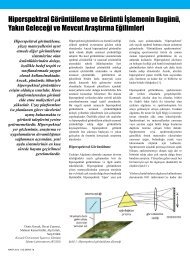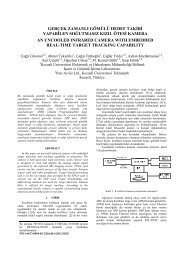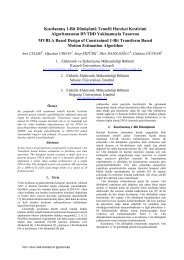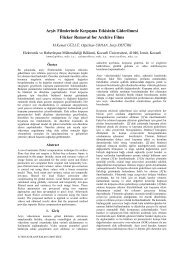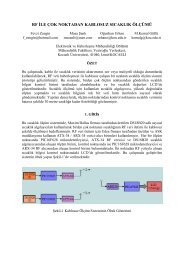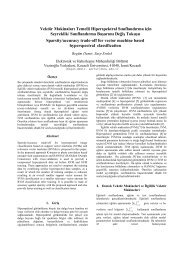Motion estimation by pre-coded image planes matching ... - KULIS
Motion estimation by pre-coded image planes matching ... - KULIS
Motion estimation by pre-coded image planes matching ... - KULIS
Create successful ePaper yourself
Turn your PDF publications into a flip-book with our unique Google optimized e-Paper software.
MOTION ESTIMATION BY PRE-CODED IMAGE PLANES MATCHING<br />
ABSTRACT<br />
This paper <strong>pre</strong>sents a new approach for block based<br />
motion <strong>estimation</strong> based on Boolean <strong>matching</strong> in <strong>pre</strong>-<br />
<strong>coded</strong> <strong>image</strong> <strong>planes</strong>. It is proposed to add redundancy to<br />
the pixel re<strong>pre</strong>sentation for the purpose of motion<br />
<strong>estimation</strong> computation reduction. Images are <strong>pre</strong>-<strong>coded</strong><br />
lo enable a Boolean-only <strong>matching</strong> criterion that<br />
approximates the mean absolute difference. Fast <strong>matching</strong><br />
criteria evaluation with a simple scheme suitable for<br />
hardware implementation is facilitated.<br />
1. INTRODUCTION<br />
<strong>Motion</strong> <strong>estimation</strong> (ME) and compensation plays a<br />
key role in video coding systems due to the ability of<br />
realizing high com<strong>pre</strong>ssion rates achieved <strong>by</strong> reducing<br />
temporal redundancies between successive <strong>image</strong> frames.<br />
<strong>Motion</strong> <strong>estimation</strong> is the most computationally intensive<br />
part of the video coding system, performing up to 50 %of<br />
the co'mputations executed <strong>by</strong> the entire coding system<br />
[I]. The most popular technique for motion <strong>estimation</strong> is<br />
block batching using the full search (FS) algorithm with<br />
mean absolute difference (MAD) or mean square error<br />
(MSE): <strong>matching</strong> criteria. Various methods have been<br />
proposed to reduce the computational load of the full-<br />
search block <strong>matching</strong> algorithm. Proposed approaches<br />
can be divided into three main categories [Z]: fast search<br />
techniques that select a subset of the possible candidate<br />
locations, techniques based on various forms of pixel<br />
patteml decimation that employ a certain sub-sampling<br />
pixel pattem, and techniques that exploit different<br />
matchibg criteria instead of tbe classical MAD.<br />
Techniques that exploit different <strong>matching</strong> criteria<br />
have (been proposed to achieve reduction in<br />
computational complexity <strong>by</strong> a simpler evaluation<br />
criterioh than the MAD. <strong>Motion</strong> <strong>estimation</strong> hy <strong>matching</strong><br />
of imake bit-<strong>planes</strong> [3], hierarchical feature <strong>matching</strong>-<br />
motion I <strong>estimation</strong> (HFM-ME) which employs sign<br />
truncated feature (STF) <strong>matching</strong> [4], and motion<br />
<strong>estimation</strong> using the one-hit transform (IBT) or the<br />
I<br />
0-7803-7750-8/03/$17.00 02003 IEEE<br />
Sarp ERTURK<br />
Electronics and Telecom. Eng. Dept.<br />
University of Kocaeli, 4 I100 Turkey<br />
11 - 347<br />
modified one-bit transform [5] are several examples of<br />
techniques proposed for a simpler <strong>matching</strong> criteria.<br />
In this paper, a novel approach for motion <strong>estimation</strong><br />
<strong>by</strong> Boolean block-<strong>matching</strong> using <strong>pre</strong>-coding of <strong>image</strong><br />
frames is proposed. By adding redundancy to the pixel<br />
re<strong>pre</strong>sentation, a reduction in the computational load of<br />
<strong>matching</strong> criteria evaluation (compared to MAD) for<br />
motion <strong>estimation</strong> is achieved. Images are <strong>pre</strong>-<strong>coded</strong> to<br />
achieve improved motion <strong>estimation</strong> performance <strong>by</strong><br />
Boolean only block <strong>matching</strong>, the coding enabling a close<br />
approximation to the MAD criterion. Coding of <strong>image</strong><br />
frames is performed only once for each frame while<br />
computations for the best match are executed<br />
exhaustively, thus the reduced computational load of the<br />
<strong>matching</strong> criterion provides a gain in computation time<br />
considering the entire motion <strong>estimation</strong> process.<br />
2. BLOCK MOTION ESTIMATION BY<br />
PRE-CODED IMAGE-PLANE MATCHING<br />
The grey level of a pixel at location (x, y) in the 1-th<br />
<strong>image</strong> frame, in a sequence with <strong>image</strong> bit-depth K, can<br />
be re<strong>pre</strong>sented as<br />
f'(x, y) = a,,2K-l +a,,zK-* + .. .+ a,2' + u020<br />
where a*, OS k < K is either 0 or 1. Block motion<br />
<strong>estimation</strong> based on hit-plane <strong>matching</strong> (BPM) evaluates<br />
the <strong>matching</strong> performance according to hit-plane<br />
correlation evaluated between the bit-<strong>planes</strong> of the<br />
current frame and the <strong>pre</strong>vious frame for each possible<br />
block displacement, using the Boolean exclusive-OR<br />
operation. The total difference measure for each motion<br />
vector candidate is obtained <strong>by</strong> weighting bit-plane<br />
correlations according to their level of significance. The<br />
reason for a degraded <strong>matching</strong> accuracy of bit-plane<br />
<strong>matching</strong> compared to the MAD criterion, is that close<br />
pixel values can result in fairly different hit-<strong>planes</strong> so that<br />
a larger difference measure can be introduced in BPM<br />
than it is actually the case.<br />
Gray-coding can be used to reduce small grey-level<br />
variations in bit-<strong>planes</strong>: pixel values are re<strong>pre</strong>sented <strong>by</strong><br />
(1)
their corresponding Gray code where successive code-<br />
words differ in only one bit position. The K-bit Gray code<br />
g,., ...g,g,g, can be formulated as<br />
gK-1 = aK-I<br />
g,=a,@u,+, for OSkSK-2<br />
(2)<br />
The k-th order Gray-<strong>coded</strong> bit-plane 8: (x,y) of an <strong>image</strong><br />
frame is defined to contain all the k-th order Gray <strong>coded</strong><br />
hits g, of the <strong>image</strong>. Gray-<strong>coded</strong> bit plane <strong>matching</strong><br />
(GC-BPM) has for instance been proposed for global<br />
motion <strong>estimation</strong> in digital <strong>image</strong> stabilizers [6] to<br />
improve on the accuracy of direct hit-plane <strong>matching</strong>.<br />
Figure I shows the assignment of the four most<br />
significant bits of the Gray-code according to the pixel<br />
range 0-255 of an 8 hit <strong>image</strong> re<strong>pre</strong>sentation. Gray-<br />
coding improves motion <strong>estimation</strong> performance<br />
compared to direct BPM. However, the block motion<br />
<strong>estimation</strong> performance of GC-BPM is still inferior to<br />
MAD due to two reasons: firstly pixels near in value can<br />
he Gray-<strong>coded</strong> into separate hit-<strong>planes</strong> at higher levels (at<br />
the more significant hit-<strong>planes</strong>) introducing a larger<br />
difference measure than it should be, and secondly pixels<br />
relatively far in value can he Gray-<strong>coded</strong> into similar bit-<br />
<strong>planes</strong> introducing a smaller difference measure than it<br />
should be.<br />
111<br />
Figure 1. Assignment of the four most significant bits of<br />
the Gray-code according to the pixel range 0-255 of an 8<br />
bit <strong>image</strong> re<strong>pre</strong>sentation.<br />
In this paper it is proposed to add redundancy to the pixel<br />
re<strong>pre</strong>sentation for the purpose of closely approximating<br />
the actual distance between pixel values <strong>by</strong> the EX-OR<br />
distance of <strong>coded</strong> bit-<strong>planes</strong>. By increasing the number of<br />
bits used to re<strong>pre</strong>sent pixel values it is possible to avoid<br />
close pixel values introducing a difference measure as a<br />
result of the EX-OR computation. Figure 2 shows the top<br />
levels of an example code carrying the desired features.<br />
The code employs three bits for the re<strong>pre</strong>sentation of the<br />
top most level. This procedure makes possible that no<br />
difference is introduced for pixels falling into the same<br />
field as well as pixels falling into adjacent fields (i.e.<br />
pixels that differ in none or only in one of the three bits),<br />
while pixel values further apart are ensured to differ in<br />
two or three hits according to their distance to each other.<br />
II - 348<br />
Increasing the number of hits used at each level, it is<br />
facilitated that only two bit differences will introduce a<br />
weighted distance so that adjacent fields do not get a<br />
distance measure introduced. Additionally, auxiliary<br />
levels are utilized to introduce a distance measure for far<br />
pixel values (solving the second problem of GC-BPM).<br />
251 D<br />
Figure 2. Assignment of the top significant bits of a<br />
sample PCIPM code according to the pixel range 0-255<br />
of an X hit <strong>image</strong> re<strong>pre</strong>sentation.<br />
The resultant codehook for an example code that can be<br />
used to re<strong>pre</strong>sent an X-hit <strong>image</strong> to satisfy the<br />
requirements, consisting of a 21 bit re<strong>pre</strong>sentation is<br />
obtained through the following coding,<br />
c13 = a4<br />
c12 = g 3<br />
where ak corresponds to the k-th hit of the pixel in the<br />
original <strong>image</strong> and g, corresponds to the k-th hit of the<br />
Gray code of the pixel. ".'I denotes Boolean AND, "+"<br />
denotes Boolean OR operation. Only the auxiliary levels<br />
require a slightly more complex Boolean arithmetic. For<br />
the <strong>matching</strong> process, each <strong>image</strong> frame is <strong>pre</strong>-<strong>coded</strong><br />
using the corresponding coding scheme and <strong>pre</strong>-<strong>coded</strong><br />
<strong>image</strong> plane <strong>matching</strong> (PCIPM) motion <strong>estimation</strong> is<br />
carried out hy simply weighting more than one bit<br />
differences at each level according to their level of<br />
significance.
Although the number of bits required per pixel for the<br />
<strong>pre</strong>-coding of <strong>image</strong>s is considerably increased, this<br />
addition of redundancy enables more accurate as well as<br />
fast EX-OR <strong>matching</strong> evaluation. Because each <strong>image</strong><br />
frame has to be <strong>pre</strong>-<strong>coded</strong> only once, while the motion<br />
<strong>estimation</strong> criteria is repeatedly executed for each block<br />
candidate position, the simplification into a Boolean only<br />
motion <strong>estimation</strong> system is worth the <strong>pre</strong>-coding<br />
overhead. It has to be noted that the EX-OR operations<br />
can be executed simultaneously in a single gate delay.<br />
3. EXPERIMENTAL RESULTS<br />
The average Peak Signal-to-Noise Ratio (PSNR) values<br />
for various video sequences reconstructed from <strong>pre</strong>vious<br />
frames using the motion vectors obtained <strong>by</strong> full search<br />
with MAD, BPM, GC-BPM, PCIPM <strong>matching</strong> are<br />
<strong>pre</strong>sented in Table I, for <strong>image</strong> frames divided into 8 x 8<br />
blocks and maximum possible motion vector<br />
displacements of (-8,7). It is clearly seen that the<br />
proposed PClPM technique considerably improves the<br />
average PSNR compared to GC-BPM and results on<br />
average in a performance very close to MAD.<br />
Table I. Average PSNR values for various video<br />
sequences reconstructed from <strong>pre</strong>vious frames using the<br />
motion vectors obtained <strong>by</strong> full search with MAD, BPM,<br />
GC-BPM, PCIPM <strong>matching</strong>.<br />
Figure 3 shows frame 44 of the table tennis sequence,<br />
together with the frames reconstructed from the <strong>pre</strong>vious<br />
frame using MAD, GC-BPM and PCIPM motion vectors.<br />
It is clearly seen that the frame reconstructed from motion<br />
vectors obtained <strong>by</strong> PClPM is almost the same as the one<br />
constructed from MAD motion vectors, while GC-BPM<br />
on occasion fails to match spatial details correctly.<br />
(d) PCIPM<br />
Figure 3. Frame # 44 of the table tennis sequence and the<br />
same frame reconstructed from the <strong>pre</strong>vious frame using<br />
MAD, GC-BPM and PCIPM <strong>matching</strong> motion vectors.
PClPM also achieves better performance than GC-BPM<br />
on a frame-to-frame basis. The PSNR of reconstructed<br />
sequences is always superior to GC-BPM, and a good<br />
deal closer to MAD. Table 11 shows for various sequences<br />
the maximum difference in the PSNR of frames<br />
reconstructed with MAD on one hand and GC-BPM and<br />
PClPM on the other. It is seen that on a frame-<strong>by</strong>-frame<br />
hasis PClPM achieves up to 1dB better than GC-BPM.<br />
Video Sequences<br />
Method<br />
FootballlSalesmanlTennis(Flowergardenl Mobile<br />
“- I 0.74 I I 1.39 1.50 I 0.65 1.39<br />
BPM<br />
Table 11. Maximum difference in the PSNR of frames<br />
reconstructed with MAD on one hand and GC BPM and<br />
PCIPM on the other.<br />
4. CONCLUSIONS<br />
A novel motion <strong>estimation</strong> procedure based on <strong>pre</strong>-<strong>coded</strong><br />
<strong>image</strong> plane <strong>matching</strong> has been <strong>pre</strong>sented. Reduction in<br />
the ME <strong>matching</strong> evaluation is achieved <strong>by</strong> adding<br />
redundancy to the pixel re<strong>pre</strong>sentation, approximating the<br />
mean absolute difference criterion. While the increase in<br />
the number of bit <strong>planes</strong> requires the utilization of a<br />
larger number of EX-OR calculations, as EX-OR<br />
<strong>matching</strong> of <strong>coded</strong> bit-<strong>planes</strong> is accomplished<br />
simultaneously the EX-OR <strong>matching</strong> process is<br />
accomplished in a single gate delay, suitable for a fast and<br />
simple hardware implementation.<br />
5. REFERENCES<br />
[I] Z.-L. He, C.-Y. Tsui. K.-K. Chan, and M.L.Liou,<br />
“Low-power VLSI design for motion <strong>estimation</strong> using<br />
adaptive pixel truncation,” IEEE Trans. Circuits Syst.<br />
Video Technol., vol.10, pp. 669-678, Aug. 2000.<br />
[2] M. Mattavelli, and G. Zoia: “Vector-tracing algorithm<br />
for motion <strong>estimation</strong> in large search windows,” IEEE<br />
Trans. Circuits Syst. Video Technol., vol.lO, pp, 1426-<br />
1437, Dec. 2000.<br />
[3] J. Feng, K.-T. Lo, H. Mehrpour, A. E. Karbowiak,<br />
“Adaptive block <strong>matching</strong> motion <strong>estimation</strong> algorithm<br />
using bit-plane <strong>matching</strong>,” in Proc. lClP’95, pp. 496 499,<br />
1995.<br />
[4] X. Lee and Y. Zhang, “A Fast Hierarchical <strong>Motion</strong>-<br />
Compensation Scheme for Video Coding Using Block<br />
Feature Matching,” IEEE Trans. Circuit Syst. Video<br />
Technol., vol. 6, pp. 627 - 635, Dec. 1996.<br />
[5] P. H. W. Wong and 0. C. Au, “Modified One-Bit<br />
Transform for <strong>Motion</strong> Estimation,” IEEE Trans. Circuit<br />
Syst. Video Technol., vol. 9, pp. 1020 - 1024, Oct. 1999.<br />
[6] S.-J. KO, S.-H. Lee, S.-W. Jeon, and E.-S. Kong, “Fast<br />
digital <strong>image</strong> stabilizer based on Gray-<strong>coded</strong> bit-plane<br />
<strong>matching</strong>“, IEEE Trans. Consumer Electronics., vol. 45,<br />
pp. 598-603, Aug. 1999.


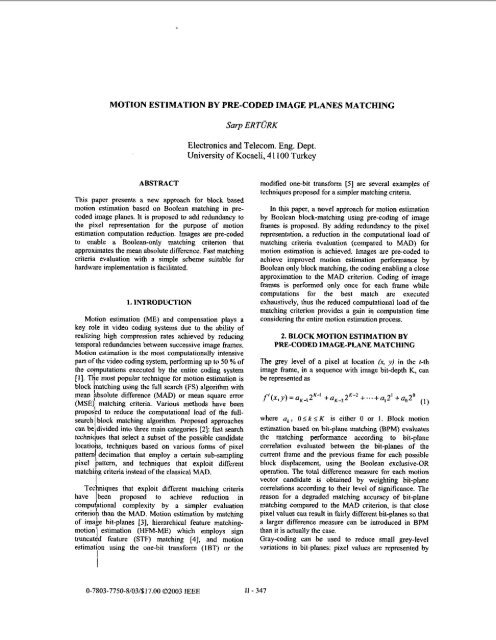


![Page 1 %XODQÕN 6 ]JHo LOH *|U QW 6WDELOL]DV\RQX M ...](https://img.yumpu.com/18085529/1/184x260/page-1-xodqon-6-jho-loh-u-qw-6wdeloldvrqx-m-.jpg?quality=85)
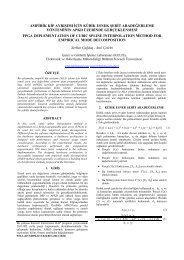
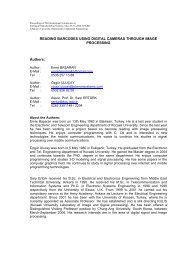
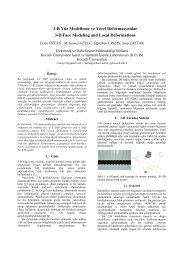
![[ ]T [ ]T - KULIS - Kocaeli Üniversitesi](https://img.yumpu.com/18085463/1/184x260/-t-t-kulis-kocaeli-universitesi.jpg?quality=85)
